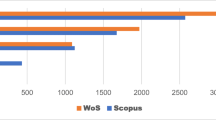Abstract
An effective bibliometric analysis was applied in this work to evaluate global scientific production of the subject category of “limnology” from 2001 to 2010. Data was based on the Science Citation Index compiled by Institute for Scientific Information (ISI), Philadelphia, USA. The h-index and NetDraw were designed to characterize the limnology publications. The results showed that the limnology research constantly increased over the past decade. The researchers paid most attention to “diatoms”, “eutrophication” and “phosphorus”. Moreover, the keywords plus of “growth”, “model”, “dynamic”, offered a thorough description for the limnology research. Among the research institutes interested in limnologic research, the US Geological Survey was the flagship while the USA attained a dominant position in the global research in the field.



Similar content being viewed by others
References
Borgatti, S. P. (2002). NetDraw network visualization. USA: Analytic technologies.
Bradford, S. C. (1934). Sources of information on specific subjects. British Journal of Engineering, 137, 85–86.
Carpenter, S. R., Caraco, N. F., & Correll, D. L. (1998). Nonpoint pollution of surface waters with phosphorus and nitrogen. Ecological Applications, 8(3), 559–568.
Cole J. J. (2009). Limnology as a discipline. Encyclopedia of inland waters (pp. 6–13). Waltham: Academic Press.
Dudgeon, D., Arthington, A. H., Gessner, M. O., et al. (2006). Freshwater biodiversity: Importance, threats, status and conservation challenges. Biological Reviews, 81, 163–182.
Garfield, E. (1990). KeyWords Plus: ISI’s breakthrough retrieval method. Part 1. Expanding your searching power on current contents on diskette. Current Comments, 32, 295–299.
Glänzel, W. (2006). On the opportunities and limitations of the H-index. Science Focus, 1(1), 10–11.
Heiri, O., Lotter, A. F., & Lemcke, G. (2001). Loss on ignition as a method for estimating organic and carbonate content in sediments: Reproducibility and comparability of results. Journal of Paleolimnology, 25(1), 101–110.
Herdendorf, C. E. (1982). Large lakes of the world. Journal of Great Lakes Research, 8(3), 379–412.
Hirsch, J. E. (2005). An index to quantify an individual’s scientific research output. Proceedings of the National Academy of Sciences of the United States of America, 102(46), 16569–16572.
Kulasegarah, J., & Fenton, J. E. (2010). Comparison of the h index with standard bibliometric indicators to rank influential otolaryngologists in Europe and North America. European Archives of Oto-Rhino-Laryngology, 267, 455–458.
Liu, X., Zhang, L., & Hong, S. (2011). Global biodiversity research during 1900–2009: A bibliometric analysis. Biodiversity and Conservation, 20, 807–826.
Tranvik, L. J., Downing, J. A., & Cotner, J. B. (2009). Lakes and reservoirs as regulators of carbon cycling and climate. Limnology and Oceanography, 54(6), 2298–2314.
Vander Zanden, M. J., & Rasmussen, J. B. (2001). Variation in delta N-15 and dela C-13 trophic fractionation: Implications for aquatic food web studies. Limnology and Oceanography, 46(8), 2061–2066.
Yi, H., & Jie, W. (2011). A bibliometric study of the trend in articles related to eutrophication published in Science Citation Index. Scientometrics, 89, 919–927.
Author information
Authors and Affiliations
Corresponding author
Rights and permissions
About this article
Cite this article
Cao, X., Huang, Y., Wang, J. et al. Research status and trends in limnology journals: a bibliometric analysis based on SCI database. Scientometrics 92, 735–746 (2012). https://doi.org/10.1007/s11192-012-0623-y
Received:
Published:
Issue Date:
DOI: https://doi.org/10.1007/s11192-012-0623-y




